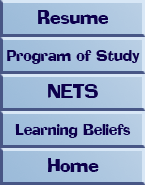NETS I. | NETS II. | NETS III. | NETS IV. | NETS V. | NETS VI.
IV. Assessment and Evaluation.
|
Teachers:
| A. apply technology in assessing student learning of subject matter using a variety of assessment techniques. |
Student learning can be assessed in a number of ways using technology. Traditionally students took exams to demonstrate what they have learned. However, with technology there are many other options for assessing student learning. Though the use of blogs, a teacher could ask the students to view multimedia material on the internet and then answer questions in an online discussion about what they have studied. Students could also reflect on the material and ask additional questions through these online discussions.
Through the use of wikis, teachers can monitor student group work by viewing access logs to monitor contributions and proofreading that each student added to the project.
As discussed in my workshop results, some teachers went beyond having their students complete a webpage about a topic to adding student made Photo Stories about their topic, or reflective Photo Stories about how they felt about doing the project.
| B. use technology resources to collect and analyze data, interpret results, and communicate findings to improve instructional practice and maximize student learning. |
Data can be easily collected through the internet by the use of surveys. Online resources for creating surveys such as SurveyMonkey can be used by teachers and students to plot and track data in a variety of subjects. Teachers can also create their own surveys with scripts on a classroom website.
Programs such as Inspiration or Kidspiration can be used to collect data on topics that students are studying and concept maps can be created to show understandings of those topics. I made use of Inspiration myself when creating my concept map on the relationship between "Teaching, Learning and Technology" to organize and express my understandings of those concepts. I have also used concept maps with my students at school to help them discuss similarities and differences between stylized pieces of art and reality. For example, while my second grade students were studying Korean art, I allowed them to discuss in small groups how tigers portrayed in Korean art are similar and different from photographs of real tigers. After the discussions, we plotted the class’ results on the board in a Venn diagram. These results were then placed in an Inspiration file and once all classes completed the task, large copies of the different diagrams were printed out so that the students could compare their answers with other classes.
Through the use of a classroom blog, teachers can analyze student understandings through the posts that they write and their interactions with other students who have posted their thoughts. This also gives the students an opportunity to learn from one another as well as reflect on the material that they have been studying.
| C. apply multiple methods of evaluation to determine students' appropriate use of technology resources for learning, communication and productivity. |
When using a classroom blog, the quality of the student posts can be assessed through rubrics that explain netiquette or other expectations regarding grammar and the content of the post. As with any rubric, a teacher should make sure that the students have seen the rubric ahead of time so that they know what expectations they should be following. Rubrics can help determine some aspects of the quality of the student discussions. However, teachers can also monitor the interactions on the blog and determine if some students put extra effort into their posts or asked additional questions within the posts that demonstrate that they are using higher order thinking skills.
In the case of the workshop on using web design in the classroom, some participants went above and beyond what the instructors expected. One teacher asked his 4th grade students create a Photo Story about their topic that was included as a multimedia file on their website. A second grade teacher had her students create a reflective Photo Story at the end of their measurement project where the students narrated over pictures of them working on the actual project and discussed what they learned and how they felt about using the technology.
NETS I. | NETS II. | NETS III. | NETS IV. | NETS V. | NETS VI.
Standards quoted from ISTE NETS - NETS for Teachers.

